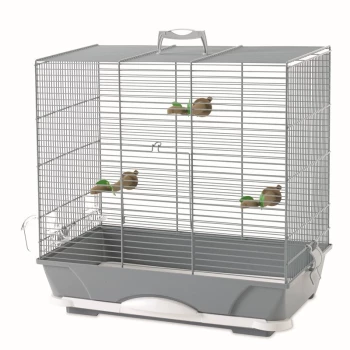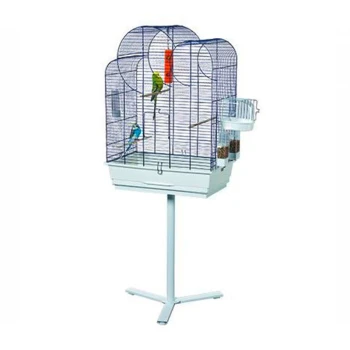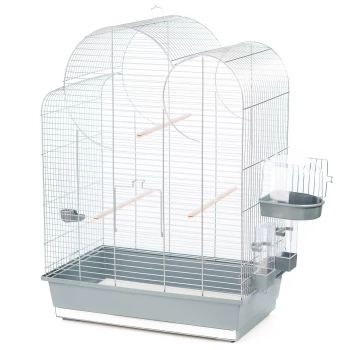Bird cages & aviaries
Bird cages & aviaries in the Maxi Zoo online shop
Aviaries and cages: a safe retreat for birds
As is true for all pets, a cage should never be a prison. Birds should feel comfortable in their aviary and be happy to visit it at any time to feed and as a safe place to sleep. Ideally, the birdhouse should always be open while the birds are under supervision. Set it up so that the birds can stay there comfortably for a while, even if you are away from home for a few hours longer.
Cages for large and small birds such as canaries, budgerigars, parakeets, parrots and other exotic birds for your home are available in various price ranges and designs in the Maxi Zoo online shop.
What are the different types of aviaries and cages?
Many aviaries are made entirely of metal bars and are therefore very robust and open. Some models have a wooden frame and a roof, for example: these aviaries are also suitable for keeping birds in the garden. If the cage is partly made of wood, some birds may feel tempted to nibble: simply offer enough alternatives in the cage, such as fresh willow twigs. The birds will most certainly prefer them.
When choosing a bird cage, please be sure not to opt for galvanised or plastic-covered cages, especially if you have a bird like a parrot! Because this kind of bird tends to nibble at the bars and hold on to them with its beak when climbing.
The entrance to the aviary must be large enough for the bird to fit through. Some cages have several openings in different sizes, sometimes the entire roof can be opened up so that the birds can get in and out even more comfortably during free flight.
A plastic drawer or tray in the bottom of the aviary makes cleaning much easier and is usually standard for bird cages and aviaries.
How should an aviary be set up?
No matter what material the bird cage is made of, the design and fittings should be adapted to the feathered occupants. In addition, there should be several seats in the cage; depending on the species of bird, the perches must be thicker or thinner and fit the size of the claws. Some cage models have integrated feeders, but these are also available as separate accessories. By adding other toys such as ladders, climbing ropes or swings to your aviary you will make it more interesting for your birds to prevent boredom.
How big do bird cages and aviaries need to be?
The answer is simple: a bird house can never be big enough. This is true even if the cage and aviary only serve as a sleeping and feeding place. Very small cages are only suitable for transport. It is difficult to give a general size in centimetres since there are both smaller and larger exotic birds and you may have varying numbers of birds. Round cages are not permitted for budgerigars and the aviary size must be at least 150 cm x 60 cm in floor space. The height must be at least 100 cm. If the birds do not have free flight, a flight area of at least 2 m³ is required for up to three pairs. It is important to remember that almost all bird species should at least be in pairs so that these social animals do not become lonely.
Note: bird aviaries should not have white bars, as they make it difficult for the birds to see outside. The distance between the bars must also be such that the birds cannot squeeze between them.
Where should a bird aviary be placed?
One criterion for the optimal location of the bird cage is to ensure that you are at about eye level with the animals. The location of the aviary should be bright, but not in full sunlight, and of course there should be no risk of draughts. It is best to place the bird cage in the room where you spend most of your time. That way the birds are always with you. Also make sure that the cage has a firm base, for example on a shelf. For larger aviaries, you can find wheeled bases in specialty shops.
How should I clean a bird cage?
Depending on the number of birds and the associated amount of droppings, you should clean bird cages every three days, but at least once a week. Here are some tips for stress-free aviary cleaning:
- It is best to remove the accessories and dismantle the cage during the birds’ free flight time.
- Remove the drawer from the bottom tray and dispose of the substrate.
- Clean the drawer and the bottom tray regularly with hot water and without using any detergent.
- Dry the floor components thoroughly and refill with new litter.
- Clean bird accessories, bars, branches and perches with a cloth and hot water; for stubborn dirt, use a sponge reserved for bird cages or a fresh toothbrush or nail brush. Items that can no longer be cleaned properly should be replaced.
Discover a large selection of bird cages and aviaries from renowned manufacturers such as Interzoo, Kerbl, MORE FOR, Pet Partner, Savic and many more in the Maxi Zoo online shop. Choose the right home for your feathered friend and have everything conveniently delivered to your home – without having to transport the often very bulky cage yourself. You can also find all accessories such as additional perches, feeders, litter and food for your birds at Maxi Zoo.



